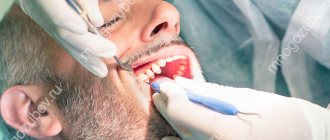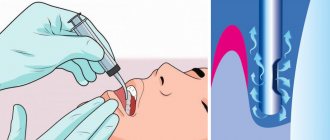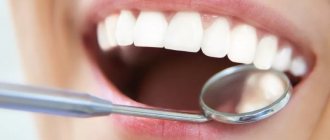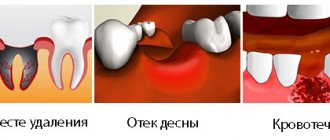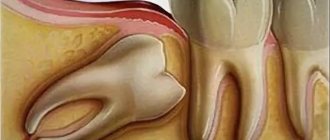What it is
Alveolitis of the socket is an inflammatory disease that appears after a tooth has been removed and the socket becomes infected. In case of a severe operation, injury to the tooth socket or gum, the risk of possible complications increases. If we talk about the norm, then the hole should heal after 2 weeks maximum. If alveolitis appears, the healing process will take much longer.
The disease occurs if an infection gets into the wound. And to avoid complications, it is worth maintaining oral hygiene after tooth extraction.
Socket bleeding
Socket bleeding, or bleeding from the socket, after tooth extraction is a normal physiological reaction that should be considered as a favorable outcome of the operation. Blood serves as a substrate for the formation of a blood clot that fills the socket. It performs hemostatic and plastic functions: it is a matrix for tissue that covers the wound defect. The following degrees of intensity of alveolar bleeding are distinguished (B. L. Pavlov, V. V. Shashkin, 1987):
- I degree - bleeding continues for more than 20 minutes, blood stains saliva and soaks gauze swabs;
- II degree - bleeding lasts more than 40 minutes, blood mixes abundantly with saliva;
- III degree - bleeding continues for 1 hour or more, there is free blood in the oral cavity.
Classification of alveolar bleeding according to the timing of development:
- primary - develops immediately after tooth extraction;
- secondary - develops some time after the operation (several hours or even days).
The source of bleeding can be wounds of soft tissues (gums, tongue, tissues of the floor of the mouth, cheeks) or the socket of an extracted tooth.
Causes of alveolar bleeding
The causes of alveolar bleeding can be local, general or mixed.
Local causes of bleeding after tooth extraction surgery:
- a mistake by the doctor who, after removing the tooth, did not apply sutures to the soft tissue wound;
- mechanical trauma, destruction of a blood clot filling the socket during eating, brushing teeth, under the influence of a vacuum that occurs in the oral cavity during smoking;
- pushing a blood clot out of a vessel when blood pressure increases, dilatation (expansion) of blood vessels, which occurs 1-1.5 hours after local injection anesthesia with the addition of vasoconstrictors (adrenaline, mesotone);
- regional arterial hyperemia that occurs when eating hot food, irrigating the oral cavity with hot solutions, herbal decoctions.
Common causes of bleeding after tooth extraction surgery:
- Arterial hypertension in the form of a hypertensive crisis in patients with hypertension or a rise in blood pressure as a result of intense physical activity, emotional stress, general thermal procedures (hot shower, steam bath), alcohol intake.
- Diseases and conditions accompanied by dysfunction of the body's coagulation system:
- hemophilia;
- thrombocytopenic purpura (Werlhof's disease);
- hemorrhagic vasculitis;
- hemorrhagic angiomatosis (Rendo-Osler disease);
- angiohemophilia (Von Willebrandt's disease);
- C-vitaminosis;
- acute leukemia;
- infectious hepatitis;
- taking anticoagulants.
Treatment of alveolar bleeding
Treatment for alveolar bleeding involves stopping it. Therefore, first of all, it is necessary to establish where it comes from. To do this, after local anesthesia, blood clots are removed with a gauze swab and the surgical area is examined. If the source of bleeding is a rupture of the gums, the mucous membrane of the oral cavity, the edges of which were not connected with sutures, sutures are applied. In cases where the edges of the gum wound are fixed and inactive, the gum can be pre-exfoliated to facilitate suturing.
If there is severe bleeding from a wound in the area of the bottom of the mouth or tongue, it is necessary to examine the edges and bottom of the wound after anesthesia. If a bleeding vessel is detected, it should be grabbed with a hemostatic clamp, a ligature applied to it and the edges of the wound brought together with sutures.
Bleeding from the alveoli is stopped in one of the following ways:
- bringing the edges of the gums together above the alveolus using sutures;
- compression of bone structures in the area of the bleeding vessel;
- tight tamponade of the alveoli with gauze turunda impregnated with an antiseptic (iodoform, xeroform).
Before introducing turunda into the alveolus, a hemostatic sponge or an osteotropic drug can be introduced in the form of a pad to activate reparative processes. To prevent premature loss of the turunda, it is fixed with a suture that brings the edges of the gums closer together. On days 6-7, when the walls of the alveoli are covered with granulation tissue, the suture is removed and the turunda is removed.
Bleeding from the interradicular septum is stopped by squeezing it with root forceps with converging cheeks, and from the vessels in the area of the alveolar bottom - by compressing the bone structures. After this, the edges of the gums are brought together with sutures above the entrance to the alveolus.
Hemostatic drugs
In case of difficult to stop diffuse bleeding from a soft tissue wound, the alveoli use hemostatic drugs of local and systemic action.
Local hemostatic drugs:
- 3% hydrogen peroxide solution;
- epsilon-aminocaproic acid;
- hemostatic sponge;
- thrombin;
- concentrated solution of potassium permanganate.
Systemic hemostatic drugs:
- 10% calcium chloride solution intravenously (slow); 10% calcium glucanate solution intravenously;
- 5% solution of aminocaproic acid 100 ml intravenous drip;
- 5% ascorbic acid solution;
- vikasol 1% - 1.0 ml;
Prevention of alveolar bleeding
Prevention of socket bleeding is as follows:
- Careful collection of anamnesis of diseases with dysfunction of the blood coagulation system. When such diseases and conditions are identified, it is necessary to consult the patient with relevant specialists to jointly draw up a plan for preparing for surgery and managing the patient in the postoperative period. Patients with hemophilia should be referred to regional specialized centers for tooth extraction.
- Careful treatment of tissues during the operation: careful detachment of the gums, control of the correct application of forceps, use of less traumatic methods of tooth extraction.
- If soft tissue damage occurs, complete the operation by bringing the edges of the wound together with sutures.
- Instructing the patient about behavior in the postoperative period and the need to take measures to prevent bleeding, taking into account the factors listed above that contribute to their occurrence.
Causes
After a tooth has been removed, alveolitis of the socket often occurs. Certain factors may contribute to this:
- the blood clot, which prevents infection from entering the wound, has been destroyed;
- bone fragments, stone, plaque got into the hole during the removal procedure;
- the specialist did not clean the hole very well from granulations and granules;
- sterility was compromised;
- the removal was very traumatic;
- the patient did not follow all the doctor’s instructions;
- The patient's body is exhausted, immunity is quite low.
When a regular tooth or wisdom tooth has been removed, you should not rinse your mouth too vigorously, as there is a risk that the blood clot located in the socket will be washed out. The result is that microbes get inside and provoke an inflammatory process.
In what cases is a repeat visit to the dentist required?
Extraction of teeth, especially wisdom teeth, does not always go well. In addition, an infection may enter the bloodstream.
To avoid harmful consequences, watch out for the following symptoms:
- gray plaque in the hole;
- high basaltic temperature lasts 3 or more days;
- At the site of removal you feel a piercing pain or pulsation.
Such symptoms indicate a malfunction in the body. Therefore, we recommend that you contact a dental surgeon again, and if you feel severe pain at night, call an ambulance.
Symptoms
Already 3 days after removal, symptoms of socket alveolitis can be observed:
- severe pain appears in the area where the tooth was pulled;
- pain spreads to areas that are located nearby;
- the body temperature rises, the patient feels unwell and shudders;
- there is an unpleasant odor from the mouth;
- the gums become red, swollen, inflamed;
- no blood clot;
- there is a specific gray coating;
- the lymph nodes under the jaws increase in size;
- there is purulent exudate.
Causes for concern
Healing may go wrong. In this case, plaque also appears at the site of the extracted tooth. However, this is no longer a fibrin film, but a sign of inflammation. Only a dentist can distinguish one from the other, since the patient will see the same light coating.
Reasons for concern:
- elevated temperature;
- throbbing, persistent pain in the wound area;
- pain spreading to the jaw, temple area and eyes;
- difficulty opening the mouth and eating;
- disorders ;
- plaque on the hole of a grayish and yellow hue;
- bleeding;
- strong odor from the mouth;
- severe inflammation of the gums.
In this case, a visit to the doctor is required. It is advisable to go to someone who removed the tooth, since he knows the nuances of the operation.
Diagnostics
Such a diagnosis is made only by a doctor when he examines the oral cavity. You can't diagnose yourself. After all, alveolitis of the socket is a serious disease.
If it is not treated promptly, serious complications are possible, including blood poisoning. If there is no blood clot at the place where the tooth was pulled out, then this indicates alveolitis.
Alveolitis photo of the hole
Often the hole may look normal, that is, without pronounced deviations, but this can be seen in the photo. But here you can consider the presence of a narrow inlet. It is also not very clear whether a clot is present in this case. Of course, making a diagnosis under such circumstances is very difficult. To do this, the doctor will have to conduct a full examination, which is performed using modern technology. And only because of the constant, very often in the form of increasing pain, smell from the open socket, tumor of the gingival tissue, can alveolitis be suspected.
Solution
Such a diagnosis must be treated in time, then after a few days the person feels better. The process includes:
- removal of remnants of a blood clot, this is done under local anesthesia;
- processing the hole and its walls with a special tool;
- treating the hole with an antiseptic solution so that the infection does not go further;
- prescription of antibiotics;
- the use of drugs that relieve pain;
- rinsing the mouth, for this you should take antiseptic solutions;
- physiotherapeutic procedures that promote rapid wound healing.
In the absence of timely treatment, osteomyelitis of the jaw bone may occur.
Medicines prescribed by specialists
When the patient has visited the dental center and had a professional treatment of the hole, he must start taking medications to cure the alveolitis. Drugs that have proven their effectiveness include:
- Hexicon. This is an antiseptic drug that is taken topically. You can use it to rinse, make mouth baths, and applications;
- Corsodil. An antiseptic medicine that has a bactericidal effect. It is also used to disinfect the mouth. Corsodil can be used to create applications, irrigation, rinsing;
- Stomatidin. An antiseptic that prevents infection from spreading. You can make applications with it, as well as rinse your mouth;
- Chlorhexidine. Antiseptic, which is known for its wide spectrum of action. It is used to treat the mucous membranes of the oral cavity and treat purulent wounds;
- Eludril. It has an antiseptic, anti-inflammatory, analgesic effect.
IMPORTANT! Professional dentists prescribe their own medication to each patient in accordance with the clinical picture and characteristics of the body, therefore it is not recommended to self-medicate so as not to aggravate the condition.
